By Marilyn May
Milford History

First United Church of Christ, Congregational recently celebrated the bicentennial of its current church building. Photo courtesy of Marilyn May.
The bell in the steeple of the First United Church of Christ, Congregational in Milford rang out recently, proclaiming to all gathered that the congregation was marking the 200th anniversary of the present church building that was dedicated in April 1824.
Today’s church is the third structure built in almost the same location. The first meeting house was constructed in 1640-41 and the second in 1727-28. Notably, the first two structures had balconies for slaves and indentured servants.
Senior Pastor Rev. Adam Eckhart asked congregants to imagine and reflect on the earliest days of the church and the faith of its founders.
“The people who founded this congregation also founded Milford in 1639. They were Puritans from Hertfordshire County, England, under the leadership of Rev. Peter Prudden, who came to start a new life and Christian community,” Eckhart said.
The Hertfordshire group was small. After landing in Boston, they soon sailed on to New Haven where they stayed for one year. During that year, it happened that a church in Wethersfield was temporarily without a pastor, so Rev. Prudden was called to preach there. He became known in that village, and many decided to travel with him when English followers were ready to move to Milford. It is estimated that as many as 200 people followed him in August 1639 along Indian trails until they came to the west bank of the Wepawaug River, just below the waterfall. (Some founders came by schooner with heavy farm equipment and cut lumber ready to construct the first shelters.)
“The plans for this third meetinghouse were bought for $25 from David Hoadley, known as ‘Connecticut’s foremost meetinghouse designer of the period,’” Eckhart said, adding that this classically New England church house was “built in the simple style that the church’s Puritan ancestors would likely be proud of. When built, there were no religious symbols in the space.”
Carol Brockett LaBrake, chair of the Trustees Ministry, said “Much has changed over 200 years. The church has had to balance the weight of history with current and future needs.”
“Congregationalists of yesteryear were against fancy objects and statues in their worship spaces,” she continued. In the early 1960s, however, after a renovation of the sanctuary, church leaders agreed to have a large cross placed in the chancel.
“A cross was made by the late Jim Merrill, a church member and builder, with the help of his two co-workers, one Catholic and the other Jewish,” she said.
They built a model and installed it to check the size and appearance of what changes would be needed in their final work. It turned out no changes would be needed.
“When the cross was installed,” LaBrake said, “there was widespread approval, and the cross has hung here ever since.”
In the earliest days of the settlement, Milford was a theocracy. The church and government were one and the same. When disagreements arose on civil matters, issues were settled by leaders whose decisions were based on Bible scriptures. And in all village issues, only male church members could vote. Slowly, practices that were once exclusive became inclusive.
Still, conventional perceptions were deeply rooted. In 1949, H.L. Menchen wrote “Puritanism – the haunting fear that someone, somewhere, may be happy.”
Today, United Church of Christ churches have the belief that “God is still speaking.” It was Jan. 25, 1961, when the church joined the newly formed UCC denomination. However, the word “congregational” was retained as part of the church’s name to reflect its founders.
All First Church pastors and associate pastors were men until 2016, when the congregation called Rev. M. Ashley Grant to become associate pastor, the first woman ever to hold that position. Some changes take longer than others. That one took 377 years.
Those who go under the expanding LGBTQIA acronym are part of the church family today. In 2019, a congregational vote affirmed that it was not enough to just say “Everyone is always welcome.” Members made what the UCC likes to call an “intentional” vote to exactly spell out what a welcome really means.
Robin Lewis, of the Music Committee, gave a presentation on the role of music, noting that “For the first 175 years of our founding, there was controversy about whether music belonged in worship, what music could be sung, who was good enough to sing it.” Later the question became, “Are the new hymns holy enough and so on. In the early 1800s, around the time this meeting house was built,” she said, “music was an integral part of worship.”
The bicentennial observance included a tour of the sanctuary by Faith Whitsett, a volunteer noted for what she does for the church, who said the sanctuary has what she called a “clear window” style that lets the light in. There is only one window with a stained-glass panel. It shows the 1640 meetinghouse. It was donated in 1911 by the Sanford family, whose ancestors were among the founding families.
The rest of the sanctuary is relatively free of ornamentation except for the tiered, many-faceted Waterford glass chandelier that was donated by the late Rev. Dr. Roy Houghten, pastor emeritus, and his wife.
Commenting on the life of today’s church members and friends, Eckhart said, “We are blessed to be a part of this history, present and future work of God.”
Marilyn May is a lifelong resident of Milford and is on the board of the Milford Historical Society.
My wife and I grew up in Milford. We haven’t been back in years. We got married in this church 40 years ago.